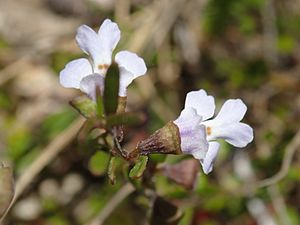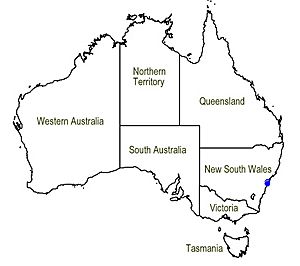Somersby mintbush facts for kids
Quick facts for kids Somersby mintbush |
|
|---|---|
 |
|
| Conservation status | |
| Scientific classification | |
| Genus: |
Prostanthera
|
| Species: |
junonis
|
 |
|
The Somersby mintbush (scientific name: Prostanthera junonis) is a special type of flowering plant. It belongs to the mint family, called Lamiaceae. This plant is endemic to the Central Coast of New South Wales, Australia. This means it only grows naturally in that specific area and nowhere else in the world! It's a small, sprawling shrub that doesn't grow very tall. It has fuzzy, egg-shaped leaves and beautiful purple or mauve flowers.
Contents
What the Somersby Mintbush Looks Like
The Somersby mintbush is a low, sprawling shrub. It often grows almost flat on the ground. It usually reaches a height of about 10 to 30 centimeters (about 4 to 12 inches). This plant doesn't smell like mint, even though it's in the mint family. Its branches are covered with long, soft hairs.
Leaves of the Somersby Mintbush
The leaves of this plant are a dull green on top and a lighter green underneath. They are shaped like a narrow egg or a narrow oval. Sometimes, their edges curl downwards, making them look more like triangles or thin lines. Each leaf is about 4 to 14 millimeters long and 3 to 6 millimeters wide. They grow on a very short stalk called a petiole, which is only about 0.5 millimeters long.
Flowers of the Somersby Mintbush
The flowers of the Somersby mintbush grow in small groups. You can find four to fourteen flowers in the upper leaf areas along the branches. Each flower sits on a tiny stalk called a pedicel, which is about 1.5 to 2.5 millimeters long.
The flowers have green parts called sepals, which sometimes have a maroon (reddish-brown) tint. These sepals are about 5.5 to 6 millimeters long and form a small tube about 1.5 to 2 millimeters long. They have two small tips, or "lobes," that are about 1.5 to 1.8 millimeters long. The sepals are usually a bit hairy and grow slightly bigger when the plant starts to produce fruit.
The main parts of the flower are the petals. They are usually pale purple to mauve, or sometimes almost white. The petals are about 7 to 12 millimeters long and have two "lips." The bottom lip has a central part that is shaped like a spatula. This part is about 4.5 to 6 millimeters long and 4 to 5.5 millimeters wide. The side parts of the bottom lip are about 4 to 5 millimeters long and 3 to 3.5 millimeters wide. The top lip of the flower is about 2 to 2.5 millimeters long and 6 to 7 millimeters wide, and it also has two small lobes.
The Somersby mintbush mostly flowers from October to February.
How the Somersby Mintbush Got Its Name
The Somersby mintbush, Prostanthera junonis, was officially described in 1997. A scientist named Barry Conn wrote about it in a scientific journal called Telopea. He studied plant samples that were collected near Somersby in 1993.
The second part of its scientific name, junonis, was chosen to honor a person named Mrs. June Gay. This way, her name is remembered through the plant.
Where the Somersby Mintbush Lives
The Somersby mintbush grows in specific types of forests and woodlands. These are called sclerophyll forests and woodlands. In these areas, the soil is usually sandy and loamy, meaning it's a mix of sand and clay, and it's found on sandstone.
You can find this special plant in the Mangrove Mountain and Sydney districts. Both of these areas are located on the Central Coast of New South Wales, Australia.
Protecting the Somersby Mintbush
The Somersby mintbush is considered an "endangered" species. This means it's at a high risk of disappearing forever if we don't protect it. Both the Australian Government, under the Environment Protection and Biodiversity Conservation Act 1999, and the New South Wales Government, under the Biodiversity Conservation Act 2016, have listed it as endangered.
Because it's so rare, a special plan has been created to help it recover and survive. The biggest dangers to the Somersby mintbush include:
- Habitat loss: When its natural home is destroyed or changed, often for farming or building.
- Hazard reduction burns: Fires that are set to reduce bushfire risks can sometimes harm the plants.
- Weed invasion: Other plants (weeds) can grow too much and take over the space and resources that the mintbush needs.
- Stormwater runoff: Water flowing from developed areas can carry pollution and harm the plant's environment.


